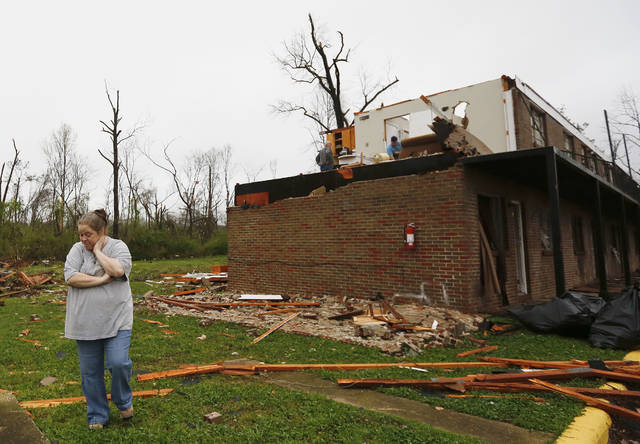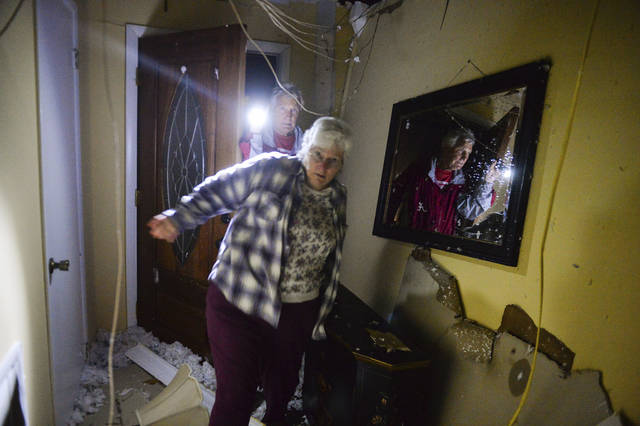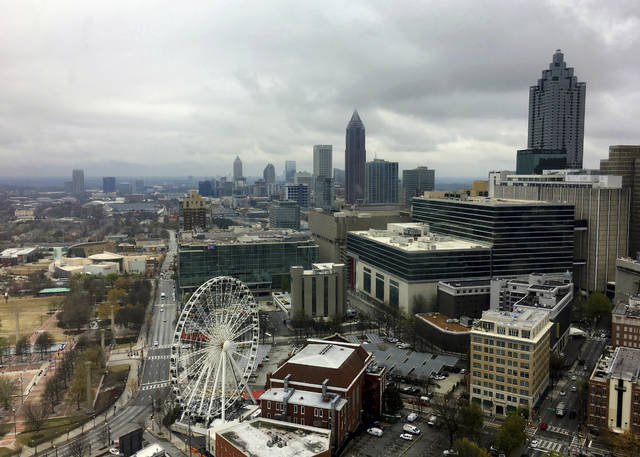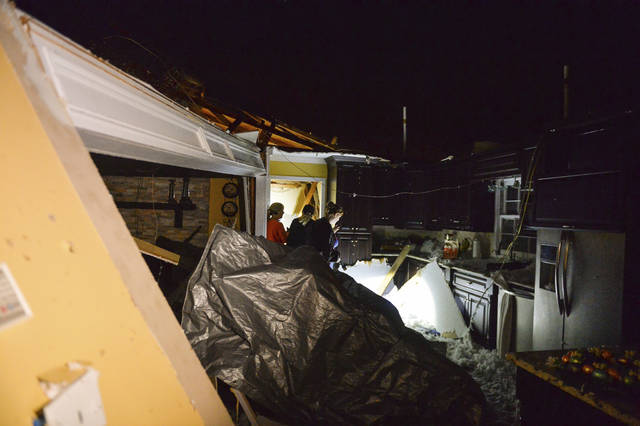JACKSONVILLE, Ala. — With violent weather plowing through the Southeast, the kitchen windows exploded at Richard Brasher’s home in eastern Alabama.
Using couch cushions for protection, Brasher hid in the bathtub with his wife, daughter and two grandchildren as the storm passed near Jacksonville State University. The roar was terrifying, Brasher said: “I thought we were gone,” he said.
Officials suspected a tornado was to blame for the damage there. With electrical transformers exploding and trees crashing down all around, Brasher, 60, said it felt like wind “picked up and shook the whole house.”
“We were scared to death. It blew the paint off my house,” he said.
The storm threatened millions of people across the Deep South, prompting tornado warnings Monday in Mississippi, Alabama and Georgia. The area around Jacksonville State University in Alabama was among the hardest hit and thousands of buildings and vehicles were battered by large hail after the night of violent weather.
Several shelters opened, schools were closed, trees and power lines were down Tuesday morning. Jacksonville State advised people to avoid traveling near campus. Most students were away for spring break.
Part of the roof was ripped off the nursing school and Pete Mathews Coliseum, a 3,500-seat basketball arena. Pieces of lumber and bent metal covered the ground along with insulation that looked like yellow cotton candy.
To the west in Cullman, the lots of automobile dealerships were full of cars and trucks that no longer had windows. The sheriff shared a photo of a county jail bombarded by hail but said the prisoners were fine.
Schools were closed in several counties because of damage. Alabama Power Co. said more than 9,000 homes and businesses were without electricity.
Forecasters had warned that the storms would threaten more than 29 million people, raising the risk of powerful tornadoes, damaging winds and hail the size of tennis balls.
Cities in northern Alabama reported power outages and the National Weather Service in Huntsville reported at least three confirmed tornadoes in the area.
The National Weather Service said five teams were out in Alabama assessing storm damage.
The weather service was also sending survey crews to at least two Georgia communities to investigate whether tornadoes caused widespread damage to homes there.
In one neighborhood near Atlanta, “it looks like someone did a bombing run down the street,” Georgia’s insurance commissioner, Ralph Hudgens, said after touring the scene Tuesday. Multiple homes were destroyed in the subdivision southwest of Atlanta, he said.
“I talked to people who were in bed when it hit, and they huddled in the bathroom with the Bible, praying,” Hudgens said. “They put the Bible against the door and they put the children in the tub. They held hands and prayed and asked the Lord to protect them. Nothing happened to them but the house was totally destroyed.”
More damage was reported in Haralson, Georgia, about 40 miles (64 kilometers) southwest of Atlanta. The Haralson County School District said schools would be closed Tuesday due to storm damage “throughout our community.”
The same storm system that battered Alabama and Georgia was taking aim Tuesday at a large part of Florida and coastal communities in Georgia and the Carolinas.
Much of north Florida and the entire Georgia and South Carolina coasts would be at an “enhanced” risk for severe storms Tuesday, which could include damaging winds, large hail and a few tornadoes, the National Storm Prediction Center. A small part of the North Carolina coastline was also included in the area most likely to see severe weather.
The area most at risk for Tuesday’s storms is heavily populated, with more than 10 million people and major Florida cities such as Jacksonville, Tampa and Orlando; Savannah, Georgia; and Charleston, South Carolina.
———
Reeves reported from Birmingham, Alabama. Mallory Moench in Montgomery, Alabama; and Jeff Martin and Kate Brumback in Atlanta contributed to this report.







